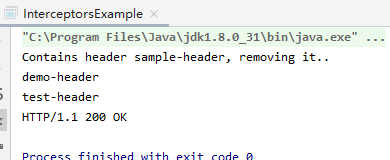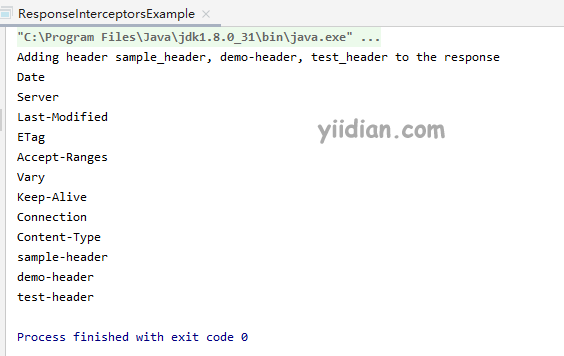HttpClient 请求拦截器
什么是HttpClient拦截器
HttpClient拦截器是帮助阻止或更改请求或响应的那些。协议拦截器通常作用于特定的标头或一组相关的标头。HttpClient 库提供对拦截器的支持。
HttpClient 请求拦截器
上述HttpRequestInterceptor接口表示请求拦截器。此接口包含一个称为进程的方法,您需要在其中编写代码块来拦截请求。
在客户端,此方法在将请求发送到服务器之前验证/处理请求,而在服务器端,此方法在评估请求正文之前执行。
如何创建HttpClient请求拦截器
您可以按照以下步骤创建请求拦截器。
第 1 步 : 创建一个 HttpRequestInterceptor 对象
通过实现其抽象方法过程来创建 HttpRequestInterceptor 接口的对象。
HttpRequestInterceptor requestInterceptor = new HttpRequestInterceptor() {
@Override
public void process(HttpRequest request, HttpContext context) throws
HttpException, IOException {
//Method implementation . . . . .
};
}
第 2 步 : 实例化 CloseableHttpClient 对象
通过向其添加上面创建的拦截器来构建自定义CloseableHttpClient对象,如下所示:
//Creating a CloseableHttpClient object
CloseableHttpClient httpclient =
HttpClients.custom().addInterceptorFirst(requestInterceptor).build();
HttpClient请求拦截器的例子
下面的例子演示了HttpClient请求拦截器的用法。在此示例中,我们创建了一个 HTTP GET 请求对象并为其添加了三个标头:sample-header、demoheader 和 test-header。
在拦截器的processor()方法中,我们正在验证发送请求的headers;如果这些标头中的任何一个是sample-header,我们将尝试删除它并显示该特定请求的标头列表。
package com.yiidian;
import org.apache.http.*;
import org.apache.http.client.methods.HttpGet;
import org.apache.http.impl.client.CloseableHttpClient;
import org.apache.http.impl.client.HttpClients;
import org.apache.http.message.BasicHeader;
import org.apache.http.protocol.HttpContext;
import java.io.IOException;
public class InterceptorsExample {
public static void main(String args[]) throws Exception{
//Creating an HttpRequestInterceptor
HttpRequestInterceptor requestInterceptor = new HttpRequestInterceptor() {
@Override
public void process(HttpRequest request, HttpContext context) throws
HttpException, IOException {
if(request.containsHeader("sample-header")) {
System.out.println("Contains header sample-header, removing it..");
request.removeHeaders("sample-header");
}
//Printing remaining list of headers
Header[] headers= request.getAllHeaders();
for (int i = 0; i<headers.length;i++) {
System.out.println(headers[i].getName());
}
}
};
//Creating a CloseableHttpClient object
CloseableHttpClient httpclient =
HttpClients.custom().addInterceptorFirst(requestInterceptor).build();
//Creating a request object
HttpGet httpget1 = new HttpGet("https://www.yiidian.com/");
//Setting the header to it
httpget1.setHeader(new BasicHeader("sample-header","My first header"));
httpget1.setHeader(new BasicHeader("demo-header","My second header"));
httpget1.setHeader(new BasicHeader("test-header","My third header"));
//Executing the request
HttpResponse httpresponse = httpclient.execute(httpget1);
//Printing the status line
System.out.println(httpresponse.getStatusLine());
}
}
输出结果为:

HttpClient 响应拦截器
上述HttpResponseInterceptor接口表示响应拦截器。该接口包含一个称为process() 的方法。在此方法中,您需要编写代码块来拦截响应。
在服务器端,此方法在将响应发送到客户端之前验证/处理响应,而在客户端,此方法在评估响应正文之前执行。
如何创建HttpClient 响应拦截器
您可以按照以下步骤创建响应拦截器
第 1 步 :创建一个 HttpResponseInterceptor 对象
通过实现其抽象方法process 来创建HttpResponseInterceptor接口的对象。
HttpResponseInterceptor responseInterceptor = new HttpResponseInterceptor() {
@Override
public void process(HttpResponse response, HttpContext context) throws HttpException, IOException {
//Method implementation . . . . . . . .
}
};
第 2 步:实例化 CloseableHttpClient 对象
通过向其添加上面创建的拦截器来构建自定义CloseableHttpClient对象,如下所示
//Creating a CloseableHttpClient object
CloseableHttpClient httpclient =
HttpClients.custom().addInterceptorFirst(responseInterceptor).build();
使用此对象,您可以照常执行请求。
HttpClient 响应拦截器的例子
下面的例子演示了响应拦截器的用法。在此示例中,我们向处理器中的响应添加了三个标头:sample-header、demo-header 和 test-header。
执行请求并获得响应后,我们使用getAllHeaders()方法打印响应的所有标头的名称。
在输出中,您可以观察列表中三个标题的名称。
package com.yiidian;
import org.apache.http.Header;
import org.apache.http.HttpException;
import org.apache.http.HttpResponse;
import org.apache.http.HttpResponseInterceptor;
import org.apache.http.client.methods.HttpGet;
import org.apache.http.impl.client.CloseableHttpClient;
import org.apache.http.impl.client.HttpClients;
import org.apache.http.protocol.HttpContext;
import java.io.IOException;
public class ResponseInterceptorsExample {
public static void main(String args[]) throws Exception{
//Creating an HttpRequestInterceptor
HttpResponseInterceptor responseInterceptor = new HttpResponseInterceptor() {
@Override
public void process(HttpResponse response, HttpContext context) throws
HttpException, IOException {
System.out.println("Adding header sample_header, demo-header, test_header to the response");
response.setHeader("sample-header", "My first header");
response.setHeader("demo-header", "My second header");
response.setHeader("test-header", "My third header");
}
};
//Creating a CloseableHttpClient object
CloseableHttpClient httpclient = HttpClients.custom().addInterceptorFirst(responseInterceptor).build();
//Creating a request object
HttpGet httpget1 = new HttpGet("https://www.yiidian.com/");
//Executing the request
HttpResponse httpresponse = httpclient.execute(httpget1);
//Printing remaining list of headers
Header[] headers = httpresponse.getAllHeaders();
for (int i = 0; i<headers.length;i++) {
System.out.println(headers[i].getName());
}
}
}
输出结果为:

热门文章
优秀文章


